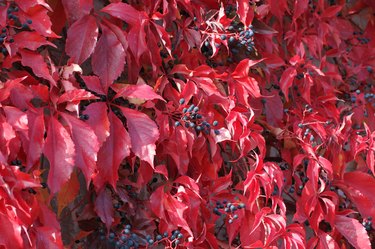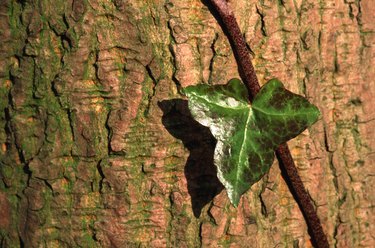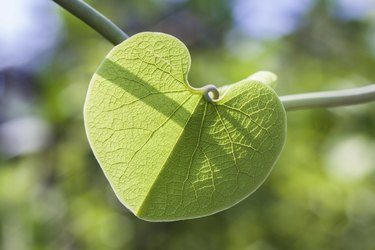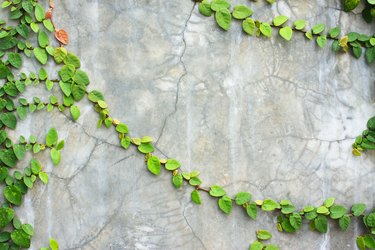Many climbing vines produce vibrant, showy blossoms, but a few produce flowers that are so inconspicuous they may go unnoticed. You might consider these to be nonflowering vines. Vines with foliage that outshines their modest flowers can have a role in the garden as a trellis-grown screen or as a leafy covering for a wall or fence.
Boston Ivy
Video of the Day

Boston ivy (Parthenocissus tricuspidata), a vigorous woody vine, can rapidly climb vertical surfaces to a height of 30 to 50 feet or more. It clings to surfaces using adhesive discs at the ends of tendrils.
Video of the Day
The plant's three-lobed leaves, which sometimes grow in clusters of three leaflets, are red-bronze when young and deepen to a dark green when they're mature. In the fall, the foliage turns red before dropping.
Boston ivy grows quickly and will cover walls, doors and windows if left unpruned. Its tendrils are difficult to remove and may damage painted surfaces, wooden structures, gutters and shutters.
Boston ivy grows in U.S. Department of Agriculture plant hardiness zones 4 through 8.
Virginia Creeper

Virginia creeper (Parthenocissus quinquefolia) is related to Boston ivy, but its leaves usually grow in clusters of five 6-inch-long leaflets. Like Boston ivy, it can reach lengths of 50 feet or more, and it clings to surfaces with similar adhesive tendrils. Its foliage ranges from purple-red when new to medium green in the summer to brilliant red in the fall.
Virginia creeper is somewhat more cold hardy than Boston ivy, and it is more tolerant of drought and heat, as well. Virginia creeper grows in USDA zones 3 through 9.
English Ivy

English ivy (Hedera helix) unlike Boston ivy and Virginia creeper, is evergreen. It grows vigorously as a trailing ground cover that spreads widely to a height of only 6 to 9 inches, but when it is allowed to climb vertically, it can reach heights of up to 100 feet. It holds on to surfaces with small, clinging roots.
English ivy grows in USDA zones 4 through 9, and it tolerates shade and drought. Its aggressive growth habit and tolerance of difficult conditions make it a problem in some climates, such as that of the Pacific Northwest, where it can crowd out native plants and is considered an invasive species.
Related species include Algerian ivy (Hedera canariensis), which grows in USDA zones 6 through 10, and Persian ivy (Hedera colchica), which grows in USDA zones 6 through 9. Algerian ivy tends to have glossier leaves than those of English ivy, while Persian ivy has large heart-shaped leaves.
Dutchman's Pipe

Dutchman's pipe (Aristolochia macrophylla), a woody vine, has large, heart-shaped leaves. It grows quickly to 30 feet. It produces unusual 2-inch-long flowers that resemble old-fashioned smoking pipes, but the flowers are typically hidden by the leaves and are not at all showy. Dutchman's pipe grows in USDA zones 4 through 8.
Creeping Fig

Creeping fig (Ficus pumila) grows aggressively to 25 or 30 feet in height. Its 1-inch-long leaves are leathery and grow from stems that cling closely to walls and other surfaces. It can tolerate freezing temperatures only for brief periods and is winter hardy only in USDA zones 8 through 11.
Creeping fig is an aggressive grower, and it requires frequent pruning to keep it from completely covering the structures on which it climbs. It will damage wood if it grows over it.
Warning
Because of their rapid growth habits and tendency to ramble over structures and other plants, many vines can be problematic if left to grow uncontrolled. English ivy is considered a noxious weed in several states, but even plants that are not officially listed as noxious or invasive, such as Boston ivy or Virginia creeper, should be monitored and pruned to prevent them from causing damage or escaping the garden.